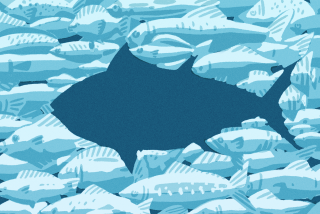Scientists Say Seafood’s Benefits Outweigh Risks
- Share via
The health benefits of eating fish twice a week outweigh the risks, but children and women of childbearing age should not eat certain types that are highly contaminated, according to a report released Tuesday by a national panel of scientists.
Seafood is rich in nutrients that help protect against heart disease, and most Americans do not eat enough, the scientists reported. It is high in protein; lower in saturated fats and cholesterol than most beef, pork and poultry; and contains more of the “good fats,” the omega-3 fatty acids that seem to protect the heart.
“The high nutritional quality of seafood makes it an important component of a healthy diet,” according to the committee of the Institute of Medicine, part of the National Academies.
Adults and children should eat two 3-ounce servings a week, and if they consume more, they should vary the types to avoid exposure to a lot of contaminants from a single source, the committee reported.
The scientists included caveats for children younger than 13 and for women who are or may become pregnant or who are nursing. They should eat the two weekly servings but “should avoid large, predatory fish such as shark, swordfish, tilefish or king mackerel” because they contain high levels of mercury, which may alter a child’s brain development. They also should limit albacore or white tuna to 6 ounces a week.
People at risk of heart disease should also eat fish twice a week, and there “may be additional benefits” if they include fish with high omega-3 content, such as salmon.
The scientists, assigned the task of balancing the benefits of seafood with the dangers posed by contaminants, echoed the 2004 guidelines of the Food and Drug Administration and the Environmental Protection Agency. But they said the message to American consumers had been fragmented and confusing, and they advised the agencies to develop new tools for informing the public.
“As consumption of seafood rises, there has been increasing concern about the potential risks” because of chemicals, heavy metals and infectious microbes in oceans and inland waters, said committee Chairman Malden Nesheim, Cornell University provost emeritus and professor emeritus of nutrition. “Consumers are therefore confronted with a dilemma. We are told that seafood is good for us and that we should be eating more of it,” yet various agencies are advising caution, he said.
“Consumers need better guidance on making seafood choices,” Nesheim said.
The 608-page report provides guidelines for different age and health-risk groups. Panel members hope agencies will turn the guidelines into “user-friendly” advice.
Environmental groups criticized the report as playing up benefits and downplaying risks. They said they found it alarming that the panel did not suggest smaller servings for children, who are more vulnerable to mercury and other contaminants.
The report “did a decent job of detailing the benefits, but did a lousy job of explaining the risks. Consumers had hoped that this study would clarify the confusion at the seafood counter, but many will still be left scratching their heads,” said Gerald Leape of the National Environmental Trust.
“Worse yet,” said seafood campaign director Jackie Savitz of the marine-habitat advocacy group Oceana, “the report attempts to undermine government advice by downplaying the mercury risks, especially with regard to children and America’s No. 1 most heavily consumed fish: tuna.”
Also on Tuesday, the Harvard School of Public Health reported in the Journal of the American Medical Assn. that a regular diet of fish reduced the risk of heart disease by 36%. “For major health outcomes among adults, the benefits of eating fish greatly outweigh the risks,” said lead author Dariush Mozaffarian.
The scientists on the national panel said they used the best available data, although they called much of the information “insufficient or too preliminary.”
For example, the panel concluded that seafood reduced the risk of heart disease, either because it replaces fattier meats or because its omega-3 fatty acids protect the heart. But they said data were insufficient to know whether people who had had a heart attack could reduce the risk of future ones by eating fish. And it is still unclear whether seafood helps prevent diabetes, cancer or Alzheimer’s disease.
People can get the most benefit and minimize risk if they pay attention to what seafood they eat, the report says.
Lean fish such as tuna and halibut are low in saturated fat and cholesterol and have moderate amounts of omega-3.
Large, predatory ones, however, accumulate high levels of mercury.
Fatty fish, particularly salmon, provide the most omega-3 but also contain more cholesterol and can build up higher amounts of polychlorinated biphenyls, or PCBs, contaminants with health risks.
Shellfish are low in saturated fat but do not contain much omega-3. Though generally low in chemicals and metals, they can contain microbes that cause infections if eaten raw.
William T. Hogarth, director of the National Marine Fisheries Service, which paid for the study with the FDA, said the report showed that “the contaminant scare is largely overblown.”
But the panel did not go that far, saying the risks to fetuses and children could be serious.
“We were surprised by the lack of reliable data on the distribution of some contaminants in the seafood supply,” Nesheim said, so “federal agencies should increase monitoring.”
Panel member David Bellinger, a Harvard Medical School professor of neurology and environmental health, said, “Because of the uncertainties, especially on the risk side, the committee felt it was important to emphasize that consumers should consume a variety of fish.”
Each type of fish contains different chemicals and concentrations, so by varying them, “benefits can be maximized but the overall risk profile can be managed,” he said.
“One of the take-home messages is that the balance of benefits and risks are different for different populations,” said Julie A. Caswell, a committee member and University of Massachusetts professor of resource economics.
The report is available through the institute’s website, www.iom.edu.
*
More to Read
Sign up for Essential California
The most important California stories and recommendations in your inbox every morning.
You may occasionally receive promotional content from the Los Angeles Times.










